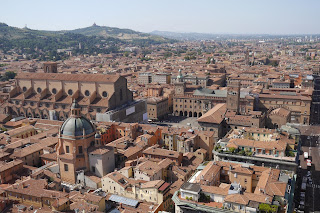The Baptistery
The final outing of our stay in Bologna is another train trip, this time to Palma. We head towards the city centre from the station and quickly reach the banks of the Palma Torrent, sadly lacking in water at present.
As we reach the centre, we are confronted by the massive bulk of the Palazzo della Pilotta. It was started in the late 16th century and never finished; a large part was demolished after damage during the second world war. What's left must be the world's ugliest palace. Inside is an art gallery, a 17th century theatre inspired by Palladio's at Vicenza and a library - all sadly closed today.
We head east into the centre, passing the San Paolo monastery (closed as well) ...
... and a rather lovely war memorial tower.
Soon we are in the Piazza del Duomo, with the Romanesque cathedral in front and the Baptistery to the right. The cathedral dates from the 11th century and has a rather severe, plain facade. The campanile is being restored and so I have cropped it out of the shot.
Inside it is entirely covered by frescoes of the 16th century, which jar somewhat at first, but create a pleasing field of colour. The Baptistery, consecrated in 1270, (see photo at the head of this post) is also wholly decorated inside, but here the style is more in keeping with the exterior. The tempera paintings and statues of seasonal activities date mainly from the time the baptistery was consecrated.
The dome is especially beautiful.
A third side of the piazza is taken up by the substantial Bishop's Palace, dating from the 11th century.
From here we head towards the strada della Republica, pausing only for lunch (a plate of Palma ham obviously, in a lovely little restaurant, the Osteria dello Zingaro). On the left of the Strada is the Palazzo Ringoni Farnese of 1572, now the Questura, which as every reader of Donna Leon knows is the police headquarters.
Further is the town hall, with another fine tower and behind it the beautiful dome of the Madonna della Steccata. The city's opera house is nearby.
At the end of the strada we crossed the river and stumbled on this stunning art deco statue. It depicts Filippo Corridoni, a trade unionist, syndicalist and journalist who volunteered for the army in the first world war and who was killed in 1915.
Finally, we saw the 16th century Ducal Palace in the Parco Ducale. The park has fine chestnut trees.
It was but a short walk from here back to the station.
Conditions: cloudy, but still quite mild.
Distance: about four miles.
Rating: four and a half stars.



















































